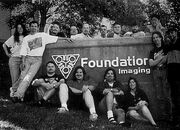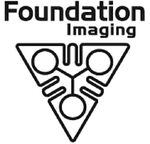Template:Realworld
Foundation Imaging, set up in 1992 in Valencia, California, and headed by founders Ron Thornton and Paul Beigle-Bryant, produced visual effects (VFX) for several Star Trek productions, as well as other genre productions, most notably Babylon 5, for which they provided groundbreaking VFX. In the process they were partly responsible for the fact that the software they used, LightWave 3D (then called Video Toaster Suite, a hardware-software combination) became an industry standard for the next two decades. For that show, which was the first to be exclusively done in computer-generated imagery (CGI), Foundation had to come up with both believable and cost effective CGI in which they succeeded convincingly. Babylon 5 was the definitive breakthrough for CGI in television productions and heralded, among others, the end of the traditional model miniature photography (or at least its predominance).

Founders and CEOs Thornton (l) and Bryant
According to CEO Thornton, Warner Brothers decided not to renew Foundation for Babylon 5 and instead decided to go in-house for the VFX, to which end Executive Producer Douglas Netter formed the new effects house Netter Digital Entertainment (NDE), which from 1995 onward became the sole supplier of CGI for the Babylon 5 franchise. This left Foundation Imaging in a precarious situation as Thornton recalled, "It was only after Babylon 5 decided not to renew us that I turned around to them [meaning Star Trek: Voyager's producers] and basically begged for work. We were in such dire straits; I had to lay everybody off – and I never thought that was going to happen – but Voyager was really wonderful and started coming in with stuff." It was former Foundation employee Mitch Suskin, now working for Voyager, who introduced the company to the producers of the show and which led to the association of the company with the Star Trek franchise. A grateful Thornton has stated in this respect, "When Babylon 5 decided they were going to do it on their own, it was absolutely devastating, but it ended up being the best thing that ever happened to me." (The Official Star Trek: Voyager Magazine, issue 16, pp. 35, 37) The move over to Star Trek in 1996, prompted some of the original employees to split off from Foundation and join Netter's company.
Outside Star Trek and Babylon 5, the company has worked as digital effects supplier on the movies The Jackal (1997), SubZero (1998), Today's Life, Max Steel, They Crawl, Shu shan zheng zhuan, and Twisted Metal: Black (the latter five all in 2001). Television production the company has worked on in the same capacity included the animation series Skeleton Warriors (1994–1995) and Roughnecks: The Starship Troopers Chronicles (1999), as well as the television movies Project Viper, Superfire (both 2002) and The Extreme Team (2003).
In later years, the company operated its own instructional facility, the Foundation Institute, to hone and further the skills of new and existing employees alike. One of its instructors at that time, was Randy Sharp, who, while not during his time at Foundation Imaging, was yet to work on Star Trek later on. [1]
Foundation Imaging closed its doors in the summer of 2002, shortly after the end of season one of Star Trek: Enterprise and had its assets sold in an auction on 12 December 2002 (as may be seen at Brian Testo Associates, LLC website). Their website, foundation-i.com, is no longer functional, and visitors to the site are redirected to a domain name holding company. Former Visual Effects Supervisor Adam Lebowitz has later reported that the entirety of Foundation's work was left on the servers when they were auctioned off, and that no formal back-ups were preserved by the copyright holding entities. [2] Upon closure of Foundation, a number of employees moved over to then recently-formed Eden FX.
Despite its relatively short lifespan, Foundation Imaging has been a signature innovative contributor to the way visual effects are produced for television productions and its influence can not be underestimated, as was evidenced by the slew of visual effects Emmy Award wins and nominations Foundation employees have garnered during the Babylon 5 and Star Trek years. The vast majority of Foundation's then staff members, has at the very least one nomination credited to his or her name, stemming from that period in time.
Star Trek association
Upon introduction by Suskin, contracting Foundation was not automatic, as Voyager's producers were wary of Foundation's visual style being so completely associated with that of Babylon 5. The company had to prove their mettle, and to this end they received Amblin Imaging's CGI USS Voyager database in order to generate establishing shots for the producers to evaluate. (The Official Star Trek: Voyager Magazine, issue 16, p. 35) Foundation passed the test and its first production commission was for the Voyager second season episode "Basics, Part I", when Dan Curry charged the company with creating the Hanonian land eel. John Teska's creation was such that Curry became definitively convinced that Foundation was up to the task. From "The Swarm" onward Foundation became the regular CGI supplier for Star Trek: Voyager. (Star Trek: The Magazine Volume 1, Issue 6, p. 46) Foundation's probation piece, the CGI USS Voyager, was later greatly improved upon by the company for it to become virtually the sole model used in the latter four seasons of the series, replacing the physical studio model.
Originally, the intention was that the CGI workload for televised Star Trek was to be divided between Foundation for Voyager and Digital Muse for Star Trek: Deep Space Nine. In practice however, the workload became such, especially in later seasons, that both companies were called upon to help each other out for specifically tasking episodes, resulting that both did CGI work for either series.
One of the studio's final projects was the late Robert Wise's director's cut of Star Trek: The Motion Picture. The drawback of the studios' short-sightedness of not willing to pay for the upkeep of the computer files, once the original production was in-the-can, became already quite obvious in 2009, when Paramount Pictures released the remastered DVD and Blu-ray editions of that movie. Only the original theatrical release could be remastered, as the computer files used by Foundation Imaging for the Director's Edition were no longer available, and which might have not bode well, costs-wise speaking, for possible remastered versions of Deep Space Nine, and Voyager in particular (it having been Foundation's primary assignment), as Lebowitz explained, "When Foundation closed down, the servers – along with the content – were auctioned off. Much of the content may have been saved by artists who worked on the series, but it would have to be tracked down. No matter how you slice it, it would be a considerable amount of work to re-integrate the entire Voyager visual effects server and re-render the FX in HD. In addition, although the series was shot on film, the entire post-production process was finished on NTSC video; to create an HD episode of Voyager, Paramount would have to go back to the vaults, re-transfer the film and re-built the episodes from scratch using the original editing data – if THOSE files still existed." [3]
However, in 2013 former Foundation staffer Robert Bonchune came forward as one of these artists who did save all of Foundation's Star Trek CGI files, elaborating, "If they ask one of us – and if they use a team that uses LightWave – it’ll be much easier for them to redo...because the guys who worked on it, like me, have the assets. We have the original ships; we have most of everything that was used [in the making of the series]. That would eliminate a ton of the cost of rebuilding." [4]
Staff

The team of Foundation Imaging, ca. 1999
- Staff
- Dave Adams
- John Allardice
- Nathan Bishop
- Rob Bonchune (1995-2002, CGI Supervisor)
- Roger Borelli (1999-2001, Digital Effects Artist)
- Paul Beigle-Bryant (1992-2002, CEO)
- Steve Burg
- Daren Dochterman (2001, Visual Effects Supervisor)
- Mike Donahue
- Pierre Drolet (1999-2002, Digital Effects Artist)
- Doug Drexler (1999-2001, Digital Effects Artist)
- P.J.Foley
- Aram Granger
- Eric Hance (1997-2002, Animation Director/Visual Effects Artist)
- Sherry Hitch (?-2002, Digital Compositor)
- Russell Isler
- Kevin Kipper
- Koji Kuramura (1993-2002, Digital Effects Artist)
- Jeremy Lang
- Adam Lebowitz (1992-2002, Visual Effects Artist/Supervisor)
- Brandon MacDougall (1997-2000, Digital Effects Artist)
- David R. Morton
- Jose Perez
- Trevor Pierce
- Steve Pugh (1992-2002, General Manager)
- Kevin "Q" Quattro
- Jeff Scheetz
- Sean Scott
- Daryl Sebert
- Randy Sharp (1999-2002, Instructor)
- Stacey Sharp
- Emile Edwin Smith
- Michael Stetson (Digital Effects Animator/Digital Modeler)
- Lee Stringer (1999-2001, Digital Effects Animator)
- Ron Thornton (1992-2002, CEO/Visual Effects Supervisor)
- Claudia Sumner
- John Teska (1993-1996, 1997-2002, Digital Effects Artist)
- Steven Toccaceli
- Dave West
Credits
Further reading
- "Foundation Imaging: Putting the CGI into Star Trek", Larry Nemecek, Star Trek Monthly issue 31, September 1997, pp. 38-42
- "Ron Thornton: CGI Effects Director", Joe Nazzaro, The Official Star Trek: Voyager Magazine, issue 16, April 1998, pp. 35-43
- "Year of Excellence", Sci-Fi & Fantasy Models, issue 32, September 1998, pp. 50-55
- "Brave new worlds for Voyager", Adam Lebowitz, Robert Bonchune, Sci-Fi & Fantasy Models International, issue 44, October 1999, pp. 24-26
- "Behind the Scenes: Foundation Imaging", Star Trek: The Magazine Volume 1, Issue 6, October 1999, pp. 46-51
- "Director's Edition VFX"; "Making it Match", Star Trek: The Magazine Volume 2, Issue 8, December 2001, pp. 52-61
External links
- Foundation Imaging at Wikipedia
- Template:IMDb-link

